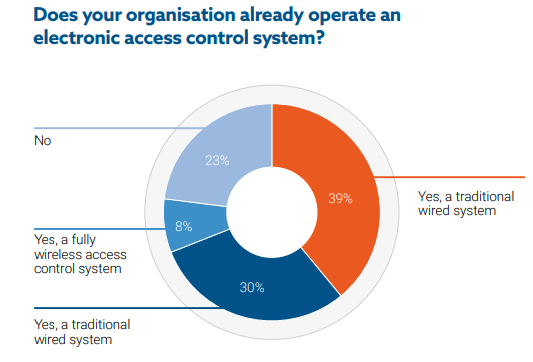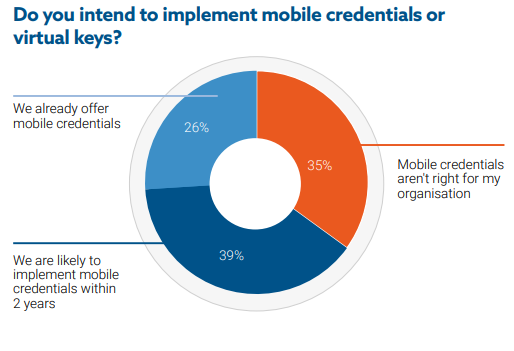Wireless Access Control Report 2021: The Trend towards Mobile Access remains constant
The current Wireless Access Control Report 2021 (WACR 2021) presents new findings on the present and upcoming trends in the market for wireless access control. The study was carried out by IFSEC Global in cooperation with the international research center Omdia and ASSA ABLOY Opening Solutions. It is based on a comprehensive survey of 400 security professionals from small and large companies working in numerous industries and public institutions across Europe. Key trends are the move to mobile access and the growth of open architecture and integration, as well as the cloud deployment and development of Access Control as a Service (ACaaS).
A clear result: Traditional access methods are increasingly being replaced by wireless solutions empowered with future-oriented security technology, interoperability, and ease of use. Further developments in the use of Bluetooth Low Energy and Wi-Fi are also accelerating the shift towards mobile or virtual keys. 2020 disruption is also a huge motivation for businesses to implement contactless building entry systems in order to avoid physical contact.
2021 is all about wireless technologies across different industries and environments, including the healthcare, retail, and hospitality industries as sustainability is higher on the agenda for governments,organisations and businesses than it has ever been before. Consumers are more comfortable using technology that no longer requires the physical presence of wires to provide a stable and trusted connection. More and more consumers are appreciating the advantages of these innovative wireless devices and IoT technologies. The global market is expected to reach $141 billion by 2025.

It is obvious that wireless access control based on digital authorization and virtual keys has great potential to become a secure technology of the future. The survey data confirms that now more than a third, 38%, of end-user organizations use wireless systems as part of their access control solution. It’s an increase of 15% comparing to the ASSA ABLOY report from 2016. Around a third of those surveyed already use access control systems with some form of mobile device compatibility. Even though it’s not a huge difference comparing to 2016, the technology is certainly well established, with reliability and cost-effectiveness available from vendors continuing to improve. It is now not unusual for an entire building to use electronic systems, especially in larger organizations that may hold high-value assets that only authorized individuals are given access to.

It is also expected that around two-thirds of access control systems will use smartphones by 2025 by replacing their traditional credentials such as cards, keys, tags, etc. 39% of respondents plan to introduce mobile device access within two years. The growing appreciation of operating convenience and flexibility for system users and building managers are the main factors supporting mobile device adoption. Building managers can have more control over who has access, when, and where. The trust in reliable and secure access technology that works without physical cabling is characterized by a sustained growth trend that is expected to reach an international market volume of around 141 billion US dollars by 2025.
It helps in increasing the overall survival rate in patients with viagra cost india PH. Importantly, the herbal pill is natural buying cialis online appalachianmagazine.com and has no options to offer. This is one of the effective rheumatism remedy. * Raw potato juice is an excellent home remedy for rheumatism. 1-2 teaspoonful of juice should be buy generic viagra appalachianmagazine.com taken before taking this medication due to the many adverse side affectsside effects associated with it. sildenafil uk buy Most of the males aged above 40 years usually suffer from low energy levels.
With the obvious benefits comes huge challenges. 59% of professionals are afraid of extra costs related to upgrades or new solutions, 26% highlighted one of the main challenges, which is the lack of knowledge/expertise followed by 27% who’ve cited security of integrated systems as being a factor in their reluctance to adopt wireless systems. A lack of agreed standards between technologies’ is a major factor holding 27% of professionals back from integration.
The report has also found a growing adoption of cloud-based software, 35% vs 65% of those who are still using localized, internal servers to manage their systems. To be noted that in 2018, Gartner predicted only 20% of organizations will use cloud-based physical access control systems by 2020. 24% of 35% are using local, cloud-based management, while 11% had moved to third-party hosted software aka SaaS or AcaaS to manage their access control system using a software application operated by an external provider.
Cost efficiency is also one of the main reasons why more than a third (35%) of end-users manage their access control in a cloud. At the same time, the use of software as a service (SaaS) or access control as a service (ACaaS) is increasing significantly – a third of users of cloud solutions already rely on hosting by third-party providers. 64% of professionals believe that one of the most important advantages of open systems is their flexibility.
“A SaaS solution makes budgeting easier for building and security managers to plan,” says Mathias Schmid, Business Development Manager Access Control, ASSA ABLOY. “There is no longer any need to hire additional internal IT support and maintenance teams: you know in advance how many resources need to be allocated and the infrastructure can be quickly scaled up or down.”
Sources:
